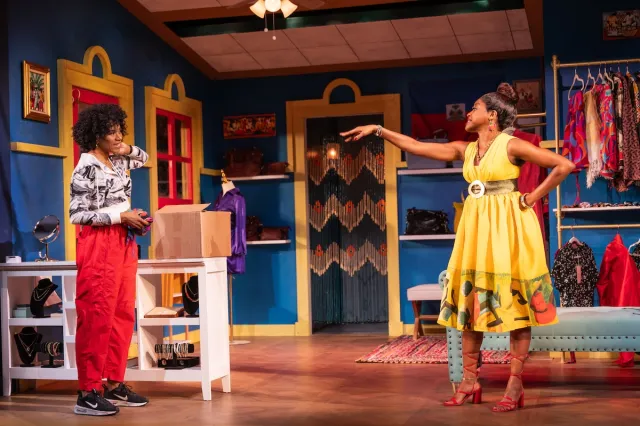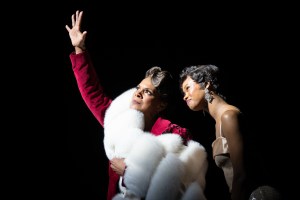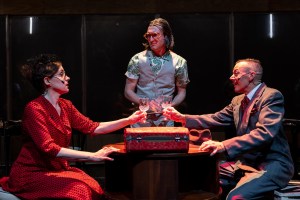Review: Dominique Morisseau Dispels Myths About Haiti and its Diaspora in Bad Kreyòl
The world premiere play runs in a co-production of MTC and Signature Theatre.

(© Matthew Murphy)
In Bad Kreyòl, Dominique Morisseau looks at her ancestral home and culture to break through cultural misconceptions surrounding Haiti. Though the play centers on Simone’s detachment from her Haitian roots, the play dismantles America’s savior complex with the country and debunks stereotypes without sugarcoating reality.
The story follows two cousins who reunite in Port-au-Prince after years apart. When they were young, Simone (Kelly McCreary) would visit Gigi (Pascale Armand) and her family, but was constantly reminded of her lack of cultural connection (and poor grasp of the language). Much of the story unfolds in Gigi’s high-end boutique, beautifully adorned by scenic designer Jason Sherwood with plush, trendy furniture, blue-clad walls and mustard yellow-framed windows. She says it was all upgraded following the devastating 2010 earthquake, which continues to widely impact everyday life and resources in the country.
McCreary and Armand both deliver strong performances, bickering as naturally as real-life relatives and exposing their respective biases in the process. Though Simone is of Haitian descent, she has absorbed a xenophobic American mentality, which is quickly revealed in the first scene, when she voices her discomfort with the Haitian practice of hiring children in servitude, providing them housing and education as compensation. Gigi retorts that the American foster care system exploits children in a similar way.On the other hand, Simone challenges Gigi’s rigidness, which she often mistakes for ill intent, but eventually understands comes from a place of concern and love. Gigi’s longtime servant-turned-brother Pita desperately wants to join the local queer community, but he faces a tangible threat to his safety, which Gigi has long prioritized over his happiness.

(© Matthew Murphy)
With captivating warmth and charm, Jude Tibeau gets big laughs as Pita while serving as the additional heart of the story as he expands Simone’s understanding of Haitian life. During one heart-to-heart in which Simone laments feeling out of place both in America and Haiti, Pita reminds her that being Haitian is not his only identity, and there are sides to himself he cannot set free as easily as she could across the ocean, declaring: “You are between worlds, so am I.”
Morisseau’s skillfully uses this scene to take a singular experience and broaden it beyond one place or community. Bad Kreyòl holds multiple truths at once, looking at the bravery it takes to be yourself despite fear of discrimination without discounting the danger that can pose. It also calls out commercial exploitation. Simone encourages Gigi to employ a former sex-worker-turned-fabric-designer named Lovelie (Fedna Jacquet), who is currently working under management that takes her previous occupation as an invitation to sexually assault her on numerous occasions. Jacquet stands out in the role with her deeply thoughtful and sensitive portrayal of Lovelie’s resigned strife. Director Tiffany Nichole Greene allows these interwoven stories and themes to unfold seamlessly, steadily pacing the two-hour play while never sacrificing nuance.
At the Saturday matinee I attended, a Haitian vendor market was held in the lobby, offering Haitian merchants the opportunity to share their products, designs, and food with patrons. All performances feature preshow music sung in Kreyòl, and the theater website offers a “deeper dive” page for patrons to become more informed on the history of the country and learn common words and phrases. A few lines of the play are spoken in Kreyòl, and it very clearly serves to enhance the experience of the titular heart of the play for those who do not speak it — Simone’s “bad Kreyòl” and all the barriers she feels with it. But barriers can be broken down, and as Morisseau says in the show’s digital program, “To love a people is to learn their language.”









